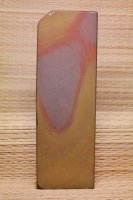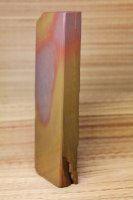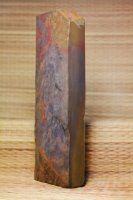Ok apparently the photo error for uploading this pic here was only an error on my Samsung tablet, but works on my iPhone.
So Alex here is a pic of the stamps.
View attachment 776650
Tom
Really nice looking stone, and everyone else's too including Steve's stones. the stones may or may not be from the Nakayama mine but from what I see I would say that they are. Who ever is using those stamps has access to some excellent stock and is doing no harm in stamping them like he is. The stamps themselves have absolutely nothing to do however with Hatanaka of Hatanaka Toishi Co. or with Kato-san the previous owner of the Nakayama mine.
These look like brand new stamps, not replicas or forgeries but instead just simple Jun Shin Sho Hon Yama (Pure Special Chosen Original Mountain) main stamp within a rectangle plus the upper right stamp Jou Seu (select best), possibly laser cut and purely decorative.
A couple of observations. Kato and Hatanaka did not lap/smooth the sides or ends of their stones but left the typical circular saw marks intact. And I think that in the near future you will begin to see more and more Maruka stamps with the Ka within a circle as Kato-san stamped some of his stones. I think you will notice if you do some research that Kato did not stamp indiscriminately small koppa (bits and pieces) stones or poorly shaped stones, but instead only the larger full bodied stones. There are exceptions, and when Hatanaka-san took over Kato's stamps some exceptions were made but in general they did not stamp every stone.
There will be large amounts of yellow kiita type koppa stones coming on the market in about a month or two, I suspect that when they reach the west they will have a simple two character kanji 中山 Naka Yama stamp. These will not be directly from the Hatanaka family. Not that they are bad stones, I have one sample for myself, but they are coming from a different wholesaler.
peace,
Alex





